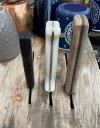I was talking about the raw properties of the steels. It is very difficult to compare two steels based on different heat treatments. And certainly I am not qualified to do so. However, I could speculate or entertain some ideas for the sake of a conversation.
If I was doing that, probably I would say that delta 3V would have considerably less wear resistance than Cruwear since it already has less wear resistance than regular 3V. Of course I do not know for sure if delta 3V has less wear resistance than regular 3V or not, but if it is more stainless than a regular 3V it might have less wear resistance. As far as I know, the increased corrosion resistance of delta 3V compared to 3V is because there is extra chromium left in the steel matrix after the heat treat compared to 3V heat treated by a standard protocol. Normally, that would mean that, since more chromium was left in the steel matrix, less chromium was used to make carbides. Of course one can argue that carbides in 3V is mostly vanadium which is correct but if one heat treat leaves more chromium carbides in the steel matrix compared to other, would not be the missing chromium would form a carbide if it was heat treated according to the industry standard heat treat? And we all know that more carbides means more wear resistance, right?


